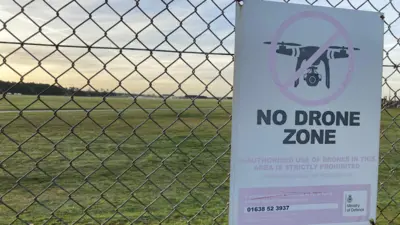We've updated our Privacy and Cookies Policy
We've made some important changes to our Privacy and Cookies Policy and we want you to know what this means for you and your data.
GodВІ - how science and religion rub along
Protests by atheists against last week's papal visit to the UK have highlighted the age old friction between religion and science. But for hundreds of years thinkers with a foot in both camps have sought to reconcile these two beliefs, says Dr Thomas Dixon.
Professor Stephen Hawking's declaration last month, that physics no longer has any need for God has been making headlines.
His new book The Grand Design uses something called M-theory to claim that the laws of physics created our universe unaided. The cosmic fireworks of the Big Bang needed no supernatural spark to set them off. They can apparently light themselves, in an endless succession of universes, like those candles on birthday cakes that are impossible to blow out.
Top Stories
So, is Prof Hawking's denial of the deity just one more example of an age-old conflict between science and religion? Does history suggest that these two great human endeavours are destined to be forever locked in battle? Not exactly.
There have been plenty of rocky moments in the relationship between faith and science, perhaps most famously the condemnation of Galileo by the Inquisition in Rome in 1633.
Top Stories
Errors and heresies
Common sense, science, and the Church had all supported the view that the Earth was stationary at the centre of the cosmos. But Galileo used observations made with his telescope to argue that the Earth was moving around the Sun.
According to some versions of the legend, Galileo was imprisoned and even tortured by the Catholic church. Neither of these things happened, but he was condemned for heresy, kept under house arrest, and forced to declare that he cursed and detested the "errors and heresies" of his scientific work.
The church repented of this scientific misjudgement at its leisure, removing works by Galileo from the index of banned books only in the 19th Century.
Then there was the famous rumpus over Moses and monkeys in Victorian Britain, when some Christians attacked Charles Darwin's theory of evolution on the grounds that it contradicted the Bible.
In Oxford in 1860, less than a year after the publication of On The Origin of Species, the tome which laid the groundwork for the theory, there was a famous spat between the Samuel Wilberforce, Bishop of Oxford, and the biologist Thomas Huxley.
Legend has it that Wilberforce, in front of a packed auditorium, asked Huxley whether he claimed descent from a monkey on the side of his grandfather or his grandmother.
It was a Victorian bishop's idea of a joke. But Huxley didn't see the funny side and, white with rage, rose to reply, rather piously, that he would rather be descended from an ape than a bishop, especially one who used his intellectual powers to introduce levity into a serious discussion.
Ape relations
Top Stories
At the time of writing his great work, Darwin himself believed in God, writing about a creator who imposed laws on matter and breathed life into nature.
"There is grandeur in this view of life," Darwin concluded, and many have subsequently agreed.
Today there are high-profile evolutionists who combine their science with religious faith.
Kenneth Miller is a Roman Catholic biologist who campaigns against the latest form of creationism to take hold in parts of America, Intelligent Design. The former head of the Human Genome Project, Francis Collins, combines Protestant belief with his work as a geneticist (and with a much less successful sideline as a religious folk-singer, which can be sampled on YouTube).
Near Darwin's grave in Westminster Abbey is that of another god of science, Sir Isaac Newton, who held the Lucasian Professorship of mathematics at Cambridge three centuries before Stephen Hawking.
We can guess what Newton would have thought of the theological conclusions of his successor. Atheism, Newton wrote, is "senseless and odious". For his own part, Newton was certain that the order of the cosmos revealed a God who was "very skilled in mechanics and geometry", a God who rather resembled Newton himself.
Vomiting bug
During the centuries that separated Newton and Darwin, many of the greatest minds saw science piling up evidence for the existence of God. Such treatises celebrated the power and goodness of God as revealed through everything from the hive-making instincts of bees and the beauty of orchids, to the engineering marvels of the human hand and eye.
Today, supporters of the Intelligent Design movement find evidence of the power and goodness of God in the rotating tail or "flagellum" of the E. coli bacterium.
For some it is a surprise, perhaps, to learn that the clearest sign of God's intelligence is to be found in a nasty vomiting bug.
Traditional religious beliefs have undoubtedly come under pressure from science over the past 400 years. The findings of modern astronomy, geology, and biology have all made it quite clear that the books of Moses, if read as scientific texts, are complete failures.
But, of course, they need not be read that way. Galileo voiced a widely-held view when he said that the Bible told you how to go to heaven, not how the heavens go.
Science and religion have had the kind of close and troubled relationship you would expect between siblings or even spouses. They share not only wonder at the majesty of the world we can see, but also a desire to find out what's behind it that we can't.
That emotional and intellectual hunger will endure longer than Professor Hawking's M-theory, and those wishing to take a truly scientific attitude may be better advised to follow the lead of the great Victorian agnostic Thomas Huxley who, in one of the last things that he wrote before he died asked "Is it not better to keep silence about matters which speech is incompetent to express; to be content with revolving in the deeps of the mind the infinite possibilities of the unknown?"
Dr Thomas Dixon is author of Science and Religion: A Very Short Introduction and is senior lecturer in History at Queen Mary, University of London.
Top Stories
More to explore
Most read
Content is not available








